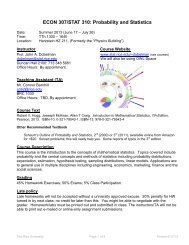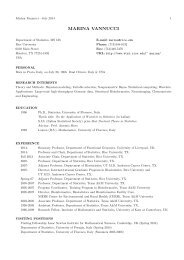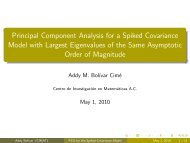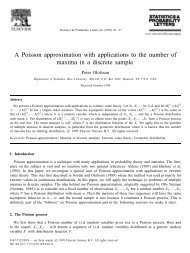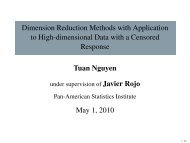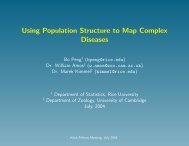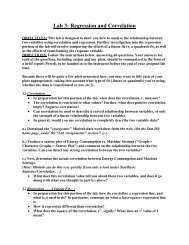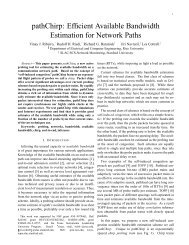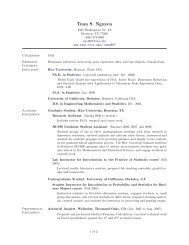Origin of Fractal Branching Complexity in the Lung - Department of ...
Origin of Fractal Branching Complexity in the Lung - Department of ...
Origin of Fractal Branching Complexity in the Lung - Department of ...
You also want an ePaper? Increase the reach of your titles
YUMPU automatically turns print PDFs into web optimized ePapers that Google loves.
major and m<strong>in</strong>or branch<strong>in</strong>g pathways. Equation 5 def<strong>in</strong>es a f<strong>in</strong>e-gra<strong>in</strong> diameter scal<strong>in</strong>g <strong>of</strong> <strong>the</strong><br />
power-law, where Rd leads to an RM such that (1< RM ≤2).<br />
Equation 6 def<strong>in</strong>es a coarse-gra<strong>in</strong><br />
−1<br />
diameter scal<strong>in</strong>g <strong>of</strong> <strong>the</strong> power-law, where γRd > Rd yields Rm ≥ 2. These branch<strong>in</strong>g relationships<br />
account for l<strong>in</strong>ear self-similar power-law behavior only, whereas power-laws with log-periodic<br />
branch<strong>in</strong>g can be observed. Such alternative behavior can be accounted for by a complex-valued<br />
fractal dimension(27).<br />
Conversely, self-similar power-law behavior <strong>in</strong> biological networks corresponds to a<br />
fractal branch<strong>in</strong>g process hav<strong>in</strong>g two network <strong>in</strong>terpretations. Eqs. 5 and 6 correspond to two<br />
classes <strong>of</strong> equivalent branch<strong>in</strong>g networks (14), which imply different connective properties <strong>in</strong><br />
shap<strong>in</strong>g <strong>the</strong> forces <strong>in</strong>volved <strong>in</strong> self-organization (4). F<strong>in</strong>e-gra<strong>in</strong>ed diameter scal<strong>in</strong>g, (R d with R M <<br />
2) represents <strong>the</strong> connective branch<strong>in</strong>g properties <strong>of</strong> an equivalent asymmetric bifurcat<strong>in</strong>g<br />
−1<br />
network with a constant D(27). Alternatively, coarse-gra<strong>in</strong>ed diameter scal<strong>in</strong>g (g Rd with Rm > 2)<br />
represents <strong>the</strong> branch<strong>in</strong>g properties <strong>of</strong> an equivalent symmetric non-bifurcat<strong>in</strong>g branch<strong>in</strong>g network<br />
without connectivity, possess<strong>in</strong>g fewer generations than <strong>the</strong> related asymmetric network for <strong>the</strong><br />
same range <strong>of</strong> diameters (14). There are several methods for summariz<strong>in</strong>g <strong>the</strong> connective and<br />
non-connective branch<strong>in</strong>g properties, R d, R m, R M and X=D 0 <strong>in</strong> biological branch<strong>in</strong>g networks.<br />
Such methods are useful, but artificial, be<strong>in</strong>g based on different topological approaches for vessel<br />
classification, such as <strong>the</strong> Horsfield (R M ≈ R H< 2) and <strong>the</strong> Strahler (R m ≈ R S> 2), or on rank<strong>in</strong>g<br />
schemas(26). If <strong>the</strong> underly<strong>in</strong>g branch<strong>in</strong>g process is a strictly self-similar branch<strong>in</strong>g fractal, <strong>the</strong>n it<br />
does not matter what method is used to characterize X=D 0 (14). However, biological branch<strong>in</strong>g<br />
networks do not branch <strong>in</strong>def<strong>in</strong>itely (7), nor necessarily with <strong>the</strong> same bifurcation design fill<strong>in</strong>g<br />
space(4, 7). Therefore, <strong>the</strong> nature <strong>of</strong> <strong>the</strong> power-law behavior is not sufficient evidence <strong>of</strong> a fractal<br />
condition(15, 16). Also necessary for establish<strong>in</strong>g a fractal condition is ei<strong>the</strong>r evidence <strong>of</strong> self-<br />
similarity <strong>in</strong> scale-<strong>in</strong>variant l<strong>in</strong>ear power-law or a self-aff<strong>in</strong>e scal<strong>in</strong>g condition <strong>in</strong> a non-l<strong>in</strong>ear<br />
scale-vary<strong>in</strong>g power-law(14). Such conditions are evaluated via a convergence test, accomplished<br />
by <strong>the</strong> evaluation <strong>of</strong> <strong>the</strong> multifractal spectrum (Figure 1) which tests for a fractal or non-fractal<br />
condition <strong>in</strong> <strong>the</strong> limit as branch<strong>in</strong>g becomes <strong>in</strong>f<strong>in</strong>ite (23).<br />
M ultifractal basis <strong>of</strong> bifurcation design.<br />
A mono-fractal network is not necessarily an optimal form that m<strong>in</strong>imizes energy<br />
dissipation <strong>in</strong> fluid transport(17-19) and does not account for <strong>the</strong> observation that bifurcation<br />
design <strong>in</strong> biological networks exhibits a distribution <strong>of</strong> values(4-5, 8). An additional symmetry-<br />
7




